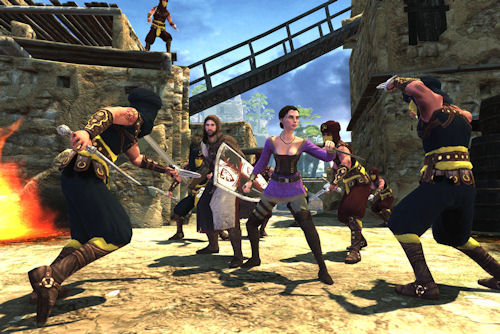

The Holy Grail. Whether you consider it the most famous Macguffin in historical fiction, a legitimate holy artifact, or simply part of the most quotable movie of all time, there’s no denying that a good Grail story is something we all enjoy. That The First Templar manages to tell a fun little story using said grail, despite an inherent Eastern European-ness to the whole experience speaks to its power.
This game centers around the Knights Templar, an organization who are quite handy if you want to talk about ancient conspiracies (Thanks, Assassin’s Creed and Gabriel Knight 3!), and are explicitly tied to Holy Grail lore, depending on who you ask (Baigent, Leigh, Lincoln and Dan Brown will definitely be nodding the affirmative).
You play as Celian d'Arestide, a humble Templar who despite his name is most decidedly not French. Celian seeks the Grail, as all heroes in these sorts of stories do, and is joined on his quest by his more... blunt... compatriot Roland as well as Marie d'Ibelin, who has also eschewed her French name in favor of being the ever popular “modern woman with anachronistic sensibilities stuck in a period drama” character. She also fights like a ninja. Go figure.

Along the way, you’ll hack and slash your way through armies of mercenaries Saracens, fanatical members of the Spanish Inquisition (whom I never expected), Hashashins and even French soldiers. Combat plays out fairly simply. Enemies will circle up around you and you mash the attack button while mixing in blocks or evasive rolls whenever an enemy’s “I’m attacking you now!” icon appears above their head. Various special attacks exist that all drain your Zeal meter, but the basic moveset should suit you fine throughout the game’s entirety.
Mixing up the combat are enemies who carry shields, which must be broken before you’ll be able to damage their owner. Archers are also a constant nuisance, though the UI is particularly good at informing the player if they’re being sighted.
Some levels are puzzle and trap-based, though with a few exceptions they never require more than paying attention to a simple pattern or using your companion character to play leapfrog with a series of switches to get both characters through a hallway. As ill-advised as they usually are in an otherwise action-heavy title, the few stealth-based sequences in The First Templar are mercifully short and forgiving to the player. Remaining unseen is (usually) only a secondary objective.
A rudimentary tracking system is in place to help you find secrets or alternate paths (usually leading to treasure or a secondary objective). Activating this mode will allow you to see treasure markers, breakable walls, pressure plates or even the odd bear trap that might be tossed casually in your way.
I’ve spoken of being able to switch to your companion character, which is nice, especially since your partner will be more interesting than the standard sword-and-board wielding Celian. Roland is an expert swordsman with a fair bit of swagger, while Marie dual-wields daggers, which she can also expend Zeal to throw. You can give simple commands to them, such as telling them to stay put while you navigate a trap-laden hallway or if you need ‘em to stand near a lever to solve a puzzle. Useful as that is, I’d rather the puzzle solving be assisted by companion AI outside of co-op (think Uncharted 2), since you’ll be bouncing between characters constantly just to toggle an obviously placed switch.
Though none of the pieces are masterworks of gameplay, they add up to a more compelling whole. Despite the fact that the entire world appears to be populated by thousands of clones of approximately seven people (including our heroes), and that accents are played fast and loose, the game manages to simply be fun to play.
The co-op support in The First Templar is surprisingly thorough, especially for a PC title. For online play you have the usual options, including drop-in/drop-out support. Each time you load up your game you’ll have the option to set online visibility for people to join up, be they friend or random encounter. In addition to the Kalypso account you’ll be making to play online, you have the interesting option to link your Facebook account to the game, allowing you to troll your friends for co-op sessions.
Splitscreen play is handled incredibly well - rather than simply split the screen in half and give each player an odd aspect ratio to play in, the screen is split into two 4:3 images, with the UI helpfully out of the way of the action. Impressively, as with the online play, splitscreen can be started or stopped at any time, which is a relative rarity and even more so on a PC.
With the exception of a handful of fights that are one-on-one duels, the entire game can be played in co-op, and the puzzle segments are definitely less annoying when you don’t have to constantly swap characters just to pull switches. Just like the single-player, you have the option of swapping who controls which character by tapping the tab key - your partner will have to confirm the request, but it flows about as smoothly as you’d want it to.
So it seems we have a paradise of co-op in The First Templar, but not everything is wine and roses, at least as far as online play goes. We were never able to get an in-progress campaign loaded in co-op until we started a fresh one with online visibility toggled on from the start. We also ran into an incredibly amusing bug that caused all doors/gates to appear shut to the second player. The only way to pass these nefarious obstacles was to swap characters and let the host run through the open doors. While funny the first few times, it really hampered our play session.
Though it may be a bug, the guest player also appears to be locked out of assigning experience points in their skill trees, despite the menu option being available to them.
Our advice: play it in split-screen if you can. Gamepads are supported out of the box, and if you have a wired 360 controller (or just one hooked up to your PC), the controls map exactly as they do on the console version. You can have one player on the keyboard and another on a gamepad if you like. It’s all good, The First Templar WANTS you to play it in co-op!
The First Templar is one of those games that you really dig despite itself. It’s not the prettiest girl in school, and it’s not a particularly deep experience, but there’s an earnest feeling to the whole affair, and come on: who doesn’t enjoy questing for the Holy Grail, especially with a friend? If it’s good enough for Indiana Jones, it’s good enough for us.